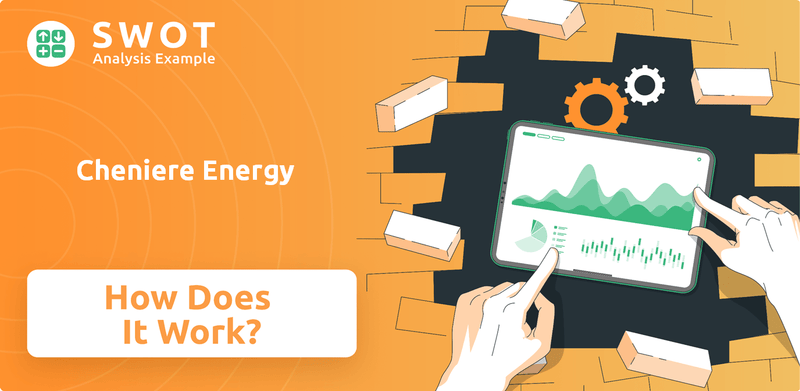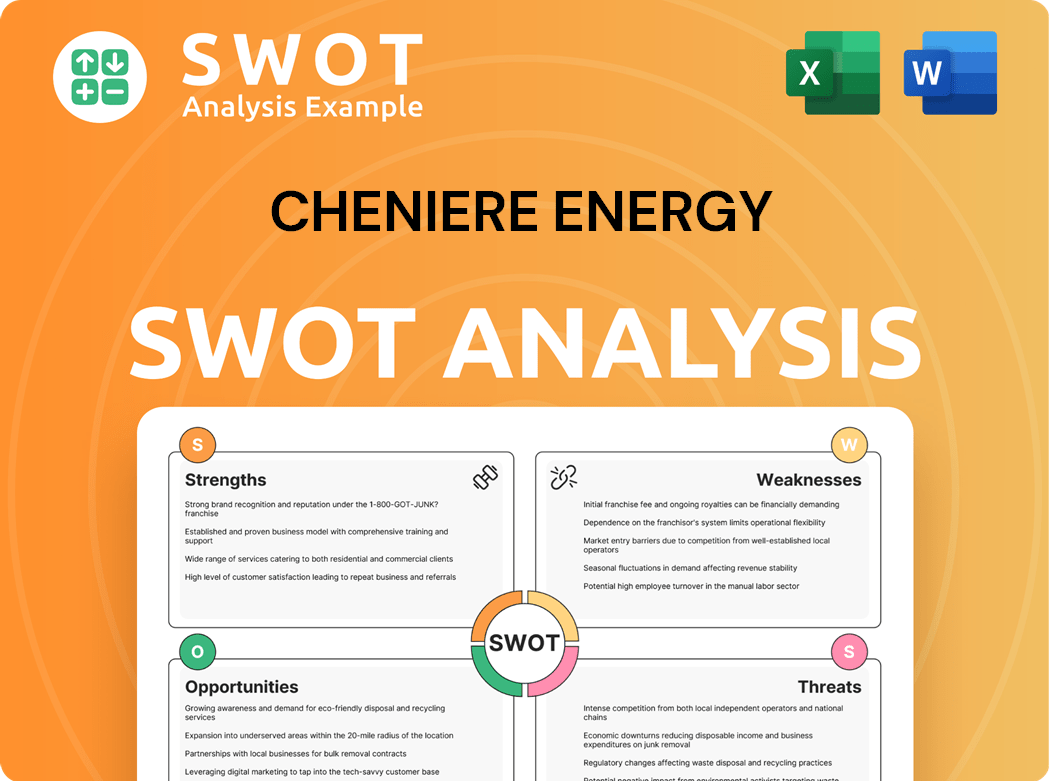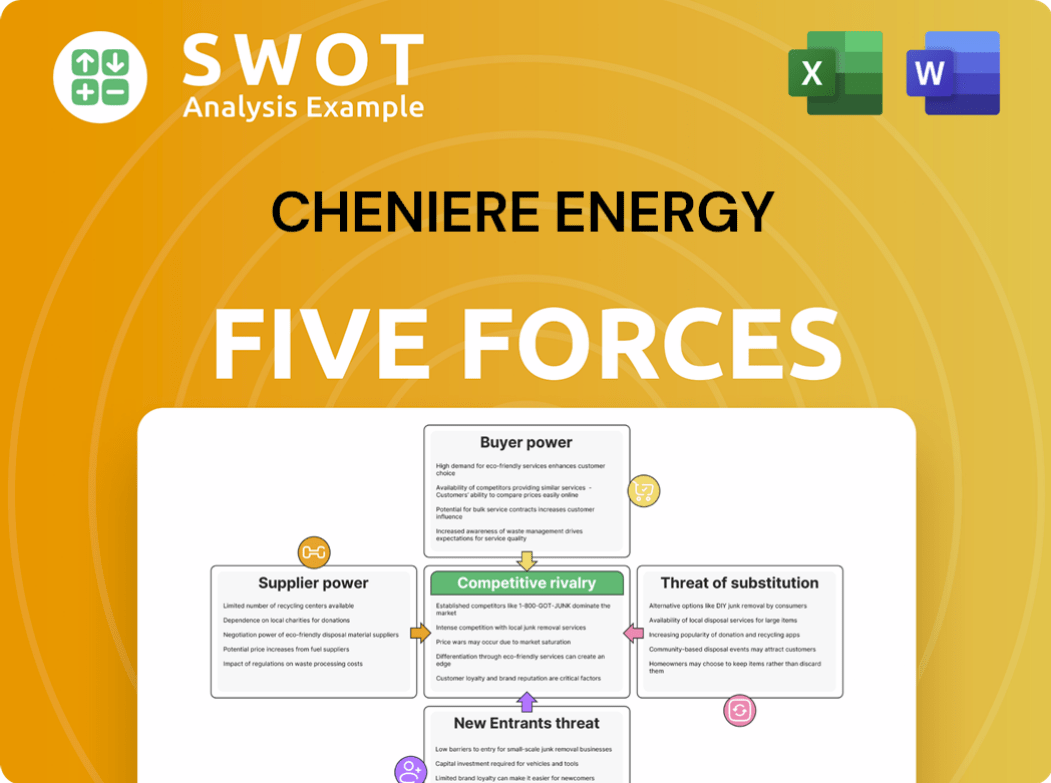Cheniere Energy Bundle
How Does Cheniere Energy Thrive in the Global LNG Market?
Cheniere Energy has revolutionized the energy landscape, transforming from an LNG import terminal developer to a global LNG export powerhouse. Its strategic shift, highlighted by the successful launch of its Sabine Pass LNG terminal, has positioned it at the forefront of the surging global natural gas trade. Today, Cheniere is a crucial player in global energy security, supplying Cheniere Energy SWOT Analysis to customers worldwide.

This exploration delves into the intricate world of this leading LNG company, examining its core operations and financial strategies. Understanding Cheniere Energy's business model is essential for investors, industry professionals, and anyone interested in the future of energy. We'll uncover how this LNG export giant generates revenue, its competitive advantages, and its impact on the global energy transition, including details on its LNG terminals and export capacity.
What Are the Key Operations Driving Cheniere Energy’s Success?
Cheniere Energy, an LNG company, focuses on liquefying and exporting natural gas. Its value proposition centers on providing long-term LNG supply contracts to a global customer base. This includes national energy companies, utilities, and large industrial users who seek reliable access to natural gas.
The company's core operations involve sourcing natural gas, primarily from U.S. shale plays, and transporting it via pipelines to its liquefaction terminals. Here, the natural gas is cooled to approximately -260°F (-162°C), converting it into a liquid state for efficient maritime transport. Cheniere then ships the Liquefied Natural Gas (LNG) to customers worldwide using specialized carriers.
Cheniere's operational efficiency and early mover advantage in the U.S. LNG export market are key differentiators. Its robust supply chain, strategic partnerships, and global distribution network enable it to provide energy security and access to competitively priced U.S. natural gas for its customers. This positions Cheniere favorably in the global energy market.
Cheniere sources natural gas from U.S. shale plays and transports it through an extensive pipeline network. This energy infrastructure is crucial for delivering natural gas to its liquefaction terminals. The efficient transportation ensures a consistent supply of gas for processing.
At the terminals, Natural gas undergoes liquefaction, cooling it to -260°F (-162°C). This process reduces the volume, making it suitable for long-distance shipping. The terminals, such as Sabine Pass and Corpus Christi, are critical to Cheniere’s operations.
The liquefied gas is loaded onto specialized LNG carriers for global delivery. Cheniere utilizes a fleet of carriers and global shipping routes to reach its customers. This efficient export process ensures timely delivery of LNG.
Cheniere primarily offers long-term LNG supply contracts. These contracts provide energy security and supply diversification for customers. The contracts are a cornerstone of Cheniere's business model.
Cheniere's early mover advantage and operational excellence set it apart from competitors. High utilization rates at its facilities, such as Sabine Pass, demonstrate this. The company's focus on reliability and efficiency provides significant benefits to its customers.
- Energy Security: Provides reliable access to natural gas for customers.
- Supply Diversification: Offers customers a diversified source of natural gas.
- Competitive Pricing: Access to competitively priced U.S. natural gas.
- Operational Excellence: High utilization rates and efficient operations.
Cheniere Energy SWOT Analysis
- Complete SWOT Breakdown
- Fully Customizable
- Editable in Excel & Word
- Professional Formatting
- Investor-Ready Format

How Does Cheniere Energy Make Money?
The [Company Name], a prominent LNG company, primarily generates revenue through the sale of liquefied natural gas (LNG) and related services. Its financial success hinges on a robust monetization strategy underpinned by long-term contracts. These contracts, often 'take-or-pay' agreements, ensure a steady revenue stream, making it a key player in the energy infrastructure sector.
The company's revenue streams are diversified, including liquefaction fees and spot market sales. Liquefaction fees, charged per MMBtu of LNG produced, cover operational costs and provide consistent income. While spot market sales offer flexibility, long-term contracts remain the cornerstone of its financial model.
The monetization strategy is built on predictable cash flows from contracted capacity, minimizing exposure to volatile natural gas prices. This approach, coupled with a globally diversified customer base, has allowed the company to navigate market fluctuations effectively. The company continues to focus on expanding its contracted capacity and optimizing operational efficiency.
Long-term LNG sales are the primary revenue source for [Company Name]. These sales are secured through 'take-or-pay' contracts, ensuring a stable income stream. These contracts guarantee payment for a specific LNG volume, regardless of actual offtake, providing revenue predictability.
Liquefaction fees are a significant revenue component. These fees are charged to customers for the service of liquefying natural gas. The fees are typically a fixed amount per MMBtu of LNG produced, covering operational costs and contributing to a consistent revenue stream.
The company also engages in spot market sales of LNG. This allows the company to capitalize on favorable market conditions. Spot sales offer flexibility and the potential to increase revenue, though they typically represent a smaller portion of total revenue compared to long-term contracts.
The monetization strategy is built on stable, predictable cash flows from its contracted capacity. This strategy minimizes exposure to volatile natural gas prices. The company primarily earns revenue on the fixed liquefaction fee and capacity reservation.
The company's revenue mix is globally diversified, with customers spanning Europe, Asia, and other regions. This diversification mitigates risks associated with reliance on a single market. This strategy helps to ensure stable revenues and reduces the impact of regional economic fluctuations.
The company focuses on expanding its contracted capacity and optimizing its operational efficiency. These efforts aim to maximize revenue generation from existing assets and future expansions. Recent financial results and strategic initiatives demonstrate this focus.
The company's financial performance is heavily influenced by its long-term contracts. The 'take-or-pay' structure provides a reliable revenue base, which is crucial for investors. The company's strategy focuses on maintaining and expanding these contracts while optimizing operational efficiency.
- Take-or-Pay Contracts: These contracts are the backbone of the company's revenue model. They provide a guaranteed revenue stream, regardless of actual LNG offtake.
- Liquefaction Fees: These fees are charged per MMBtu of LNG produced, covering operational costs and contributing to a consistent income stream.
- Market Dynamics: The company actively monitors global natural gas markets to optimize its sales strategies. This includes spot market sales to capitalize on favorable conditions.
- Expansion and Optimization: The company is focused on expanding its liquefaction capacity and improving operational efficiency to maximize revenue generation. The company's Marketing Strategy of Cheniere Energy also plays a key role.
- Geographic Diversification: The company's customer base is globally diversified, reducing the risk associated with reliance on a single market. This diversification helps to stabilize revenue streams.
Cheniere Energy PESTLE Analysis
- Covers All 6 PESTLE Categories
- No Research Needed – Save Hours of Work
- Built by Experts, Trusted by Consultants
- Instant Download, Ready to Use
- 100% Editable, Fully Customizable

Which Strategic Decisions Have Shaped Cheniere Energy’s Business Model?
The journey of Cheniere Energy, a leading LNG company, to becoming a global leader in Liquefied Natural Gas (LNG) is marked by significant milestones and strategic decisions. A pivotal move was the conversion of its Sabine Pass LNG import terminal into an export facility. This groundbreaking initiative, which began commercial operations in 2016, reshaped the company and the U.S. energy sector, establishing the U.S. as a major LNG exporter. The completion of the Corpus Christi LNG terminal was another major milestone, further expanding Cheniere's liquefaction capacity and strengthening its market position.
Cheniere has consistently focused on optimization and expansion projects, such as the Sabine Pass Stage 3 expansion, to boost its overall liquefaction capabilities and meet the growing global demand. These strategic investments underscore the company's commitment to increasing its LNG export capacity and solidifying its role in the global energy market. These expansions are crucial for meeting the increasing demand for natural gas worldwide.
Navigating volatile natural gas prices, ensuring reliable supply chain logistics, and adapting to evolving regulatory environments have presented operational and market challenges. During periods of extreme weather or geopolitical instability, Cheniere has demonstrated resilience in maintaining operations and fulfilling commitments. The company responded to market downturns by focusing on its robust portfolio of long-term, take-or-pay contracts, which provided stable cash flows even amidst market fluctuations. For more insights, consider exploring the Growth Strategy of Cheniere Energy.
The conversion of the Sabine Pass terminal into an export facility in 2016 was a game-changer. The completion of the Corpus Christi LNG terminal further expanded its capacity. Ongoing expansion projects, like Sabine Pass Stage 3, continue to boost liquefaction capabilities.
Cheniere focused on long-term, take-or-pay contracts for stable cash flow. The company has adapted to market fluctuations by focusing on its robust portfolio of long-term contracts. Strategic investments in infrastructure have been key to meeting global demand.
Cheniere's first-mover advantage in U.S. LNG exports has been significant. Economies of scale from its large operations provide lower costs. Its integrated business model, from procurement to shipping, offers efficiency and reliability.
Cheniere has had to navigate volatile natural gas prices and ensure reliable supply chains. Adapting to evolving regulatory environments has also been crucial. The company has shown resilience during extreme weather and geopolitical instability.
Cheniere's competitive advantages are multifaceted, including its first-mover advantage and economies of scale. Its integrated business model, from natural gas procurement to liquefaction and shipping, offers a competitive edge. The company is expanding its capacity and exploring initiatives to reduce its carbon footprint. In 2024, Cheniere exported approximately 1.4 billion cubic feet per day from its Sabine Pass facility.
- First-mover advantage in U.S. LNG exports.
- Economies of scale from large-scale operations.
- Integrated business model enhances efficiency.
- Strategic location on the U.S. Gulf Coast.
Cheniere Energy Business Model Canvas
- Complete 9-Block Business Model Canvas
- Effortlessly Communicate Your Business Strategy
- Investor-Ready BMC Format
- 100% Editable and Customizable
- Clear and Structured Layout

How Is Cheniere Energy Positioning Itself for Continued Success?
As a leading LNG company, Cheniere Energy (LNG) holds a prominent position in the global energy market. The company is a major LNG export player, significantly influencing the supply dynamics of Liquefied Natural Gas worldwide. Its operational scale, particularly through its Sabine Pass and Corpus Christi terminals, underscores its substantial market share and impact on the global energy landscape.
Cheniere Energy's strategy and operations face several challenges, including regulatory changes, competition, and technological advancements. These factors, along with geopolitical events and economic fluctuations, can significantly influence its profitability and market position. The company's ability to navigate these risks will be critical to its long-term success and maintaining its leading role in the natural gas industry.
Cheniere Energy is a leading LNG company, specifically in the U.S. Its LNG export terminals, such as Sabine Pass and Corpus Christi, contribute significantly to the global supply. The company benefits from long-term contracts and strategic importance to energy-importing nations, enhancing its market position.
Regulatory changes, competition, and technological disruptions pose risks to Cheniere. Geopolitical events and economic downturns can impact energy demand and pricing. Market volatility, as seen in late 2024 and early 2025, continues to be a factor influencing the company's performance.
Cheniere aims to capitalize on the global demand for natural gas, particularly as a bridge fuel. Expansion projects and a strong contract portfolio support its growth. The company's future remains positive, driven by increasing reliance on natural gas in the international energy landscape.
Focus on optimizing operations, expanding projects like Sabine Pass Stage 3, and reducing carbon intensity. Cheniere is actively involved in discussions about energy transition scenarios. Leadership is committed to sustainable operations and meeting growing global energy needs.
Cheniere Energy's operational strategy includes optimizing existing infrastructure and pursuing expansion opportunities, such as the Sabine Pass Stage 3 project. The company is also focused on reducing its carbon footprint and exploring ways to support the energy transition. For more details, read this article about Growth Strategy of Cheniere Energy.
- LNG Export Capacity: Cheniere's LNG export capacity is a key factor in its market position, with significant volumes from its terminals.
- Financial Performance: The company's financial performance is closely tied to global natural gas prices and demand, impacting its revenue and profitability.
- Market Dynamics: Cheniere operates within a dynamic market influenced by geopolitical events, regulatory changes, and technological advancements.
- Future Plans: The company's future plans involve expanding its operational capabilities and adapting to the evolving energy landscape.
Cheniere Energy Porter's Five Forces Analysis
- Covers All 5 Competitive Forces in Detail
- Structured for Consultants, Students, and Founders
- 100% Editable in Microsoft Word & Excel
- Instant Digital Download – Use Immediately
- Compatible with Mac & PC – Fully Unlocked

Related Blogs
- What are Mission Vision & Core Values of Cheniere Energy Company?
- What is Competitive Landscape of Cheniere Energy Company?
- What is Growth Strategy and Future Prospects of Cheniere Energy Company?
- What is Sales and Marketing Strategy of Cheniere Energy Company?
- What is Brief History of Cheniere Energy Company?
- Who Owns Cheniere Energy Company?
- What is Customer Demographics and Target Market of Cheniere Energy Company?
Disclaimer
All information, articles, and product details provided on this website are for general informational and educational purposes only. We do not claim any ownership over, nor do we intend to infringe upon, any trademarks, copyrights, logos, brand names, or other intellectual property mentioned or depicted on this site. Such intellectual property remains the property of its respective owners, and any references here are made solely for identification or informational purposes, without implying any affiliation, endorsement, or partnership.
We make no representations or warranties, express or implied, regarding the accuracy, completeness, or suitability of any content or products presented. Nothing on this website should be construed as legal, tax, investment, financial, medical, or other professional advice. In addition, no part of this site—including articles or product references—constitutes a solicitation, recommendation, endorsement, advertisement, or offer to buy or sell any securities, franchises, or other financial instruments, particularly in jurisdictions where such activity would be unlawful.
All content is of a general nature and may not address the specific circumstances of any individual or entity. It is not a substitute for professional advice or services. Any actions you take based on the information provided here are strictly at your own risk. You accept full responsibility for any decisions or outcomes arising from your use of this website and agree to release us from any liability in connection with your use of, or reliance upon, the content or products found herein.